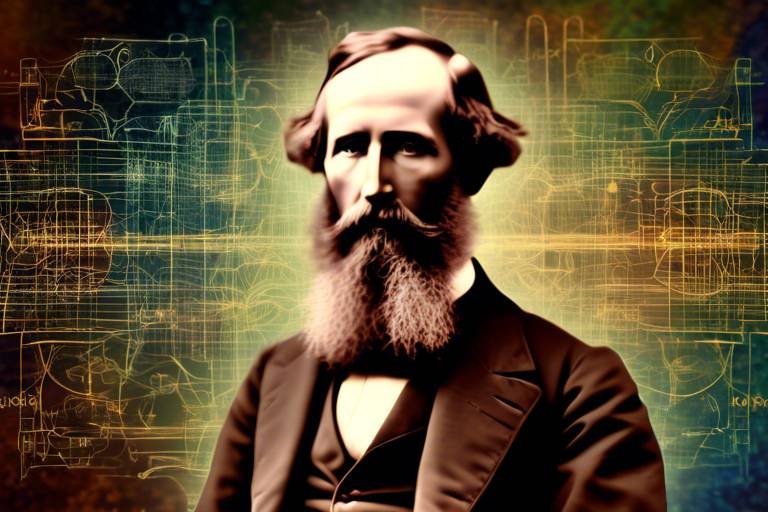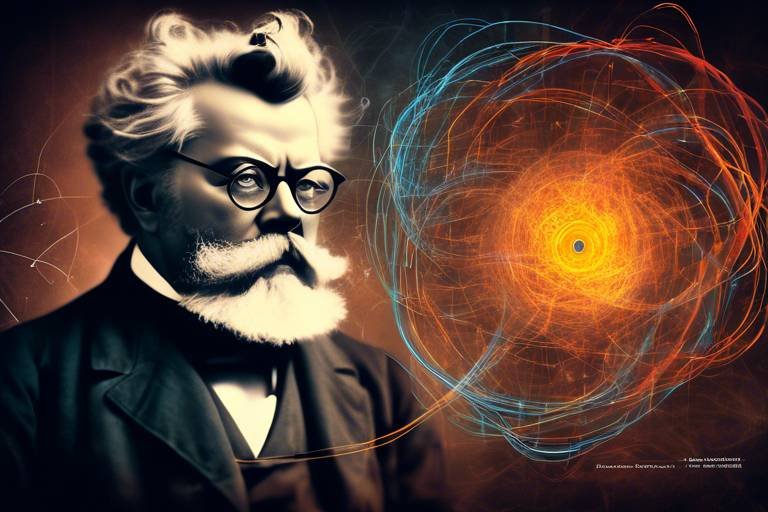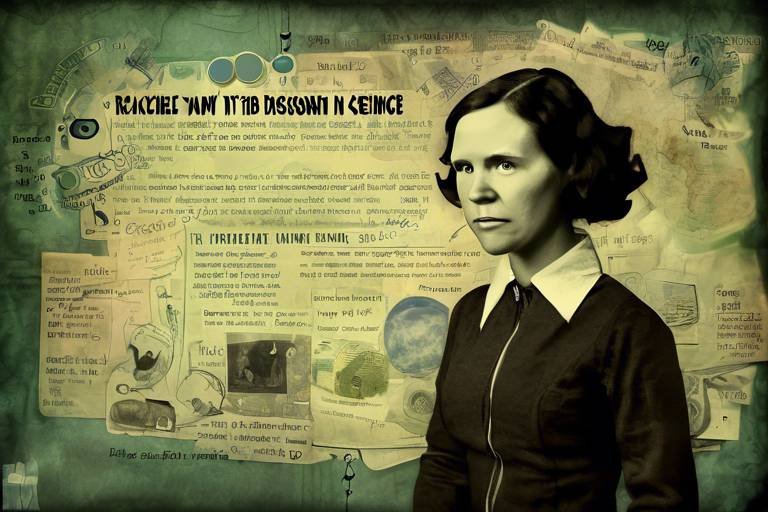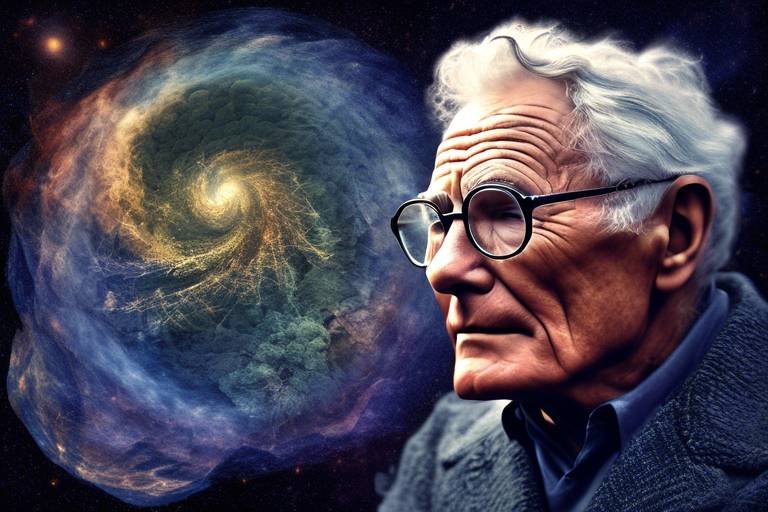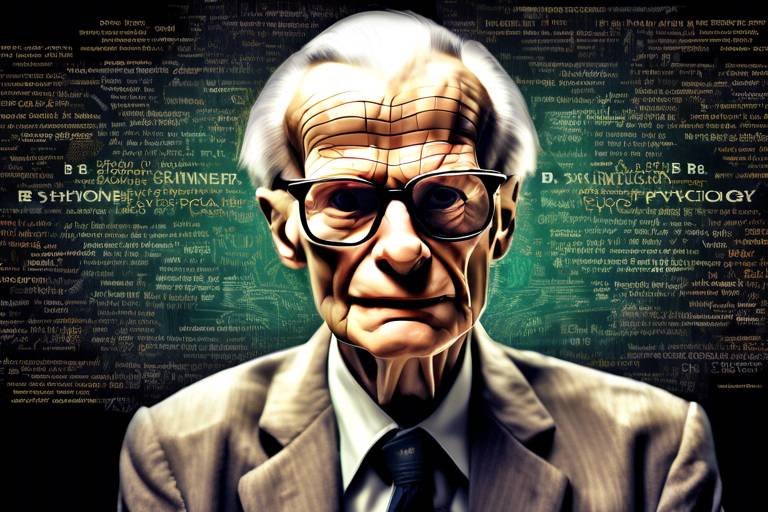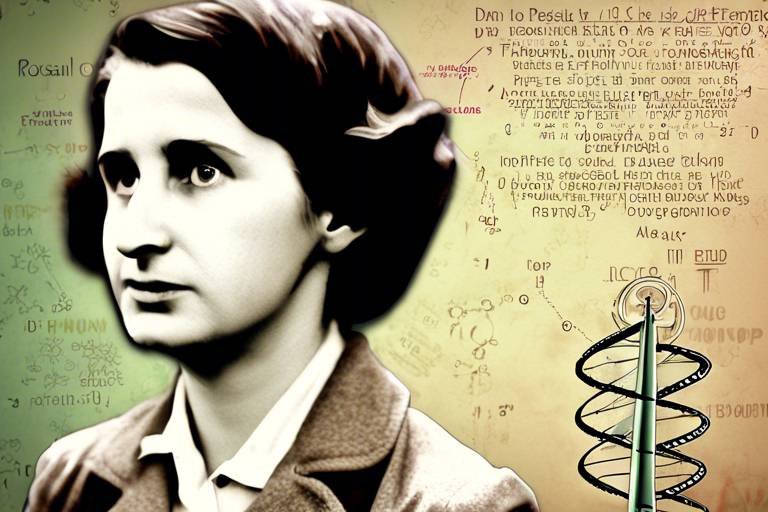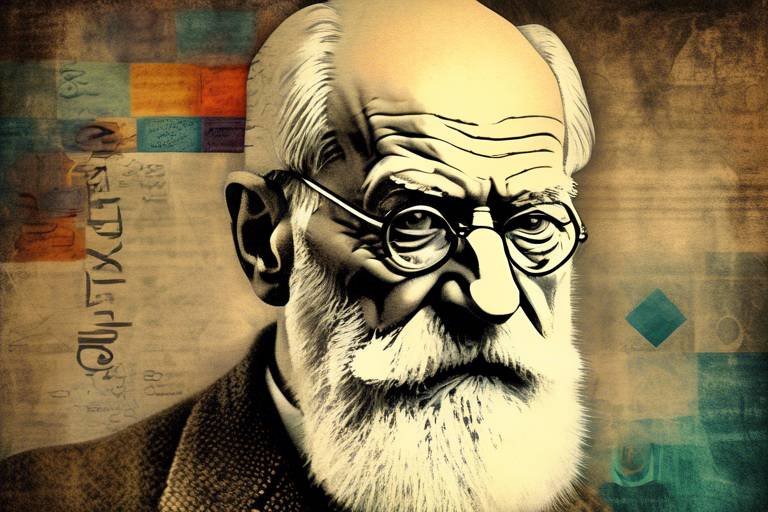The Life of James Clerk Maxwell and Electromagnetism
James Clerk Maxwell was not just a name in the annals of science; he was a pioneer whose work laid the very foundation of modern physics. Born on June 13, 1831, in Edinburgh, Scotland, Maxwell's journey was marked by a profound curiosity and an insatiable desire to understand the mysteries of the universe. His contributions to electromagnetism have not only shaped theoretical physics but have also propelled technological advancements that we often take for granted today.
Maxwell's life story is nothing short of fascinating. Imagine a young boy, captivated by the world around him, often found with his nose buried in books about mathematics and physics. His early education was influenced by notable figures, including his mother, who recognized his potential. By the age of 14, he had already developed a keen interest in geometry, and his passion for science only grew from there. This early fascination set the stage for his future breakthroughs.
As Maxwell pursued his studies at the University of Edinburgh and later at Cambridge, he began to formulate ideas that would eventually culminate in his groundbreaking work on electromagnetism. His ability to connect seemingly disparate concepts was remarkable. He saw electricity and magnetism not as separate entities but as parts of a greater whole, paving the way for his revolutionary theories.
In the grand tapestry of scientific history, Maxwell's contributions stand out like a bright star. His work was not just theoretical; it provided the tools and frameworks that would enable future scientists to explore the realms of quantum mechanics and relativity. Maxwell's equations, which elegantly describe the behavior of electric and magnetic fields, are fundamental to our understanding of the physical world. They are so integral that they are often compared to Newton's laws of motion in their importance.
In summary, the life of James Clerk Maxwell is a testament to the power of curiosity and intellect. His journey from a curious child in Scotland to a revered scientist is an inspiring narrative that reminds us of the profound impact one individual can have on the world. As we delve deeper into Maxwell's theories and their implications, we uncover not just the man behind the equations, but the very essence of electromagnetism itself.
- What are Maxwell's equations? Maxwell's equations are a set of four fundamental equations that describe how electric and magnetic fields interact and propagate through space.
- Why is James Clerk Maxwell important? Maxwell is considered one of the most significant figures in physics due to his unification of electricity, magnetism, and light into a single theoretical framework.
- How did Maxwell's work influence technology? His theories laid the groundwork for technologies such as radio, television, and modern telecommunications, fundamentally changing how we communicate.
- What legacy did Maxwell leave behind? Maxwell's legacy includes numerous honors, institutions named after him, and a profound influence on future generations of scientists.

Early Life and Education
James Clerk Maxwell was born on June 13, 1831, in Edinburgh, Scotland. From a young age, he exhibited an insatiable curiosity about the world around him. His mother, a skilled mathematician, and his father, a prominent land surveyor, fostered an environment rich in intellectual stimulation. This nurturing upbringing played a crucial role in shaping his scientific inclinations. Imagine a young boy, peering through a makeshift telescope, captivated by the stars—this was Maxwell, a child destined to unravel the mysteries of the universe.
Maxwell's early education began at the Edinburgh Academy, where he excelled in mathematics and natural philosophy. He was not just a bookworm; he was known for his playful experiments and innovative thinking. For instance, he created a simple but effective apparatus to demonstrate the principles of geometry, which showcased his knack for blending theory with hands-on experimentation. This hands-on approach would later become a hallmark of his scientific career.
After completing his studies at the Academy, Maxwell enrolled at the University of Edinburgh at the tender age of 16. There, he was introduced to the works of great scientists like Isaac Newton and Michael Faraday. The exposure to such pioneering ideas ignited a spark in him, pushing him to delve deeper into the realms of physics and mathematics. He later transferred to the University of Cambridge, where he became a member of the prestigious Trinity College. At Cambridge, he not only honed his mathematical skills but also developed a profound understanding of electromagnetic theory, which would become the cornerstone of his future work.
During his time at Cambridge, Maxwell's intellect shone brightly. He won the prestigious Smith's Prize for his work on the stability of Saturn's rings, which showcased his ability to apply mathematical principles to physical phenomena. This early achievement was a precursor to his later groundbreaking contributions to electromagnetism. It was during these formative years that Maxwell began to cultivate relationships with other brilliant minds, such as Lord Rayleigh and J.J. Thomson, who would influence his thinking and career trajectory.
Maxwell's education was not limited to formal institutions; he was also a voracious reader and a keen observer of nature. He often took long walks in the Scottish countryside, where he would ponder the complexities of light, color, and motion. These contemplative excursions allowed him to connect theoretical concepts with the physical world, laying the groundwork for his later discoveries. His unique blend of rigorous academic training and personal exploration set him apart as a thinker who was not afraid to question established norms.
In summary, James Clerk Maxwell's early life and education were marked by an extraordinary blend of curiosity, creativity, and academic excellence. His childhood experiences and educational journey not only shaped his scientific pursuits but also laid the foundation for his revolutionary contributions to electromagnetism. As we delve deeper into his theoretical contributions, it becomes clear that the seeds of innovation were sown early in his life, leading to a legacy that continues to influence modern science and technology.

Theoretical Contributions to Electromagnetism
James Clerk Maxwell's impact on the field of electromagnetism is nothing short of revolutionary. Before Maxwell, electricity and magnetism were seen as two separate entities, like two sides of a coin that had yet to be flipped. Maxwell changed the game by showing that these forces are intrinsically linked, forming the foundation of what we now call electromagnetism. His work not only unified these two fields but also laid the groundwork for countless technological advancements that we take for granted today.
At the heart of Maxwell's contributions are his famous equations, which elegantly describe how electric and magnetic fields interact. These equations are not just mathematical expressions; they are the key to understanding the behavior of electromagnetic waves, which include visible light, radio waves, and X-rays. Imagine trying to navigate a ship without a compass; that’s how scientists felt before Maxwell provided them with a clear direction through his equations.
Maxwell's equations consist of four differential equations that describe how electric and magnetic fields are generated and altered by each other and by charges and currents. Let’s break down each equation to appreciate their significance:
| Equation | Description |
|---|---|
| Gauss's Law for Electricity | This equation states that the electric flux through a closed surface is proportional to the charge enclosed within that surface. |
| Gauss's Law for Magnetism | It indicates that there are no magnetic monopoles; the total magnetic flux through a closed surface is zero. |
| Faraday's Law of Induction | This law shows how a changing magnetic field creates an electric field, which is the principle behind electric generators. |
| Maxwell-Ampère Law | This law states that magnetic fields can be generated by electric currents and by changing electric fields. |
These equations are not just theoretical musings; they have practical applications that can be seen in everyday technology. For instance, when you tune into your favorite radio station, you are directly benefiting from the principles laid out in Maxwell's equations. They are the reason why we can transmit information wirelessly over vast distances, a feat that has transformed communication and technology.
The implications of Maxwell's equations extend far beyond the realm of physics. They have paved the way for various technological advancements, including:
- Telecommunications: Enabling wireless communication through radio waves.
- Medical Imaging: Forming the basis for technologies like MRI (Magnetic Resonance Imaging).
- Electromagnetic Devices: Influencing the design of electric motors, generators, and transformers.
Maxwell's work essentially opened the door to the modern technological era. Without his contributions, we might still be stuck in a world where electricity and magnetism were treated as isolated phenomena, rather than the interconnected forces they truly are.
The experimental validation of Maxwell's theories was crucial in solidifying his contributions to science. One of the most notable experiments was conducted by Heinrich Hertz in the late 19th century, who demonstrated the existence of electromagnetic waves. Hertz's experiments confirmed Maxwell's predictions, showing that electromagnetic waves could be generated and detected—this was a monumental moment in physics, akin to discovering a new continent.
In conclusion, Maxwell's theoretical contributions to electromagnetism were not merely academic; they were transformative. They reshaped our understanding of the physical world and laid the groundwork for technological advancements that have profoundly impacted society. The beauty of Maxwell's work lies in its simplicity and elegance, encapsulating complex phenomena in a set of equations that continue to inspire scientists and engineers today.
- What are Maxwell's equations? Maxwell's equations are a set of four fundamental equations that describe how electric and magnetic fields interact.
- Why are Maxwell's contributions important? His work unified electricity and magnetism, leading to major advancements in technology and our understanding of the universe.
- How did Maxwell's equations influence modern technology? They form the basis for technologies such as radio, television, and medical imaging devices.

Maxwell's Equations
When we talk about the foundations of electromagnetism, we simply cannot overlook the brilliance of James Clerk Maxwell. His equations, known as Maxwell's Equations, are not just a collection of mathematical expressions; they are the very language of electromagnetism, describing how electric and magnetic fields interact and propagate through space. These four equations, elegantly simple yet profoundly complex, unify the separate realms of electricity and magnetism into a cohesive framework that has changed the course of physics forever.
To break it down, Maxwell's Equations can be summarized as follows:
| Equation | Description |
|---|---|
| Gauss's Law | Describes how electric charges produce electric fields. |
| Gauss's Law for Magnetism | States that there are no magnetic monopoles; magnetic field lines are closed loops. |
| Faraday's Law of Induction | Indicates how a changing magnetic field creates an electric field. |
| Maxwell-Ampère Law | Shows that electric currents and changing electric fields produce magnetic fields. |
Each of these equations plays a crucial role in understanding how electromagnetic waves propagate. For instance, Gauss's Law tells us that the electric field diverges from positive charges and converges on negative ones, providing insight into electric field behavior. Meanwhile, Faraday's Law reveals the fascinating phenomenon of electromagnetic induction, which is the principle behind electric generators and transformers.
What makes Maxwell's Equations so revolutionary is their ability to predict the existence of electromagnetic waves. Imagine standing on a beach, watching the waves roll in. The behavior of these waves can be described using Maxwell's framework. Just as ocean waves travel through water, electromagnetic waves travel through the vacuum of space, allowing for the transmission of radio waves, light, and even X-rays. This realization opened the door to a plethora of technological advancements, from wireless communication to medical imaging.
In a nutshell, Maxwell's Equations are not merely theoretical constructs; they form the backbone of modern physics and technology. They have stood the test of time, continuously proving their validity through experimental validation and practical application. As we delve deeper into the implications of these equations, it becomes clear that Maxwell's genius was not just in formulating these laws but in understanding their profound implications for the universe.
- What are Maxwell's Equations? Maxwell's Equations are a set of four fundamental equations that describe how electric and magnetic fields interact and propagate.
- Why are they important? They unify the concepts of electricity and magnetism and are essential for understanding electromagnetic waves, which are crucial for many technologies today.
- How did Maxwell derive these equations? Maxwell combined existing laws of electricity and magnetism, adding his own insights, particularly regarding the displacement current, to create a comprehensive theory.
- What are some applications of Maxwell's Equations? They are foundational for technologies such as radio, television, radar, and even medical imaging techniques like MRI.

Implications of Maxwell's Equations
Maxwell's equations are not just a collection of mathematical statements; they are the very foundation upon which modern technology stands. When we think about the implications of these equations, it's like peering through a window into the future of science and engineering. Imagine a world without the conveniences of electricity, wireless communication, or even the internet. It's hard to fathom, right? Maxwell's work essentially unified electricity and magnetism, revealing that these two seemingly separate forces are interconnected phenomena. This groundbreaking realization has had profound implications across various fields.
One of the most significant implications is the development of electromagnetic waves. Maxwell predicted that electric and magnetic fields could propagate through space as waves, which travel at the speed of light. This idea was revolutionary! It laid the groundwork for technologies such as radio, television, and even mobile phones. Without Maxwell's equations, the very concept of transmitting information wirelessly would be nothing more than a dream.
Furthermore, Maxwell's equations have also influenced the field of optics. They provided a theoretical framework for understanding light as an electromagnetic wave. This connection between light and electromagnetism has opened doors to numerous applications, from fiber optics to laser technology. The implications extend even further into medical technologies, such as MRI machines, which rely on electromagnetic fields to produce detailed images of the human body.
To illustrate the vast reach of Maxwell's equations, let's consider a few key areas where their implications are profoundly felt:
- Telecommunications: The principles of electromagnetic radiation have allowed for the development of wireless communication systems, enabling everything from mobile phones to satellite communications.
- Energy Generation: Maxwell's equations govern the principles behind generators and transformers, which are essential for producing and distributing electrical energy.
- Medical Imaging: Techniques like MRI and CT scans utilize electromagnetic principles to visualize the internal structures of the body.
The beauty of Maxwell's equations lies in their ability to describe a wide range of physical phenomena with just a few elegant equations. They serve as a bridge between theoretical physics and practical applications, demonstrating how abstract concepts can lead to tangible innovations that transform our daily lives. In essence, Maxwell's work is a testament to the power of human curiosity and intellect, showing us that understanding the universe can lead to incredible advancements.
In conclusion, the implications of Maxwell's equations are vast and varied, impacting numerous aspects of our lives and shaping the technological landscape of the modern world. As we continue to explore the universe, Maxwell's contributions remind us of the interconnectedness of nature and the endless possibilities that arise from understanding it.
What are Maxwell's equations?
Maxwell's equations are a set of four fundamental equations that describe how electric and magnetic fields interact and propagate. They form the foundation of classical electromagnetism.
Why are Maxwell's equations important?
These equations are crucial because they unify electricity and magnetism into a single theory, leading to the development of various technologies, including radio, television, and wireless communication.
How did Maxwell's work influence modern physics?
Maxwell's work laid the groundwork for later developments in physics, including quantum mechanics and the theory of relativity, fundamentally changing our understanding of the physical world.
What technologies rely on Maxwell's equations?
Many technologies, including electrical power generation, telecommunications, and medical imaging devices like MRI machines, rely on the principles established by Maxwell's equations.

Experimental Validation
The journey of scientific discovery is often paved with experimental validation, and in the case of James Clerk Maxwell, this journey was nothing short of revolutionary. Maxwell's theoretical framework for electromagnetism was not merely a collection of equations; it was a bold assertion that electricity and magnetism were interconnected. However, for a theory to be accepted in the scientific community, it must withstand rigorous testing and validation through experiments. Maxwell's predictions were eventually confirmed through a series of landmark experiments that demonstrated the profound implications of his work.
One of the most significant experiments that validated Maxwell's theories was conducted by Heinrich Hertz in the late 1880s. Hertz's experiments involved generating electromagnetic waves and demonstrating their properties, which directly aligned with Maxwell's predictions. He created sparks that emitted radio waves, which could be detected at a distance, illustrating the existence of electromagnetic radiation. This was the first experimental confirmation of Maxwell's theory, showing that light itself is an electromagnetic wave. Hertz's work not only validated Maxwell's equations but also opened the door to a new realm of technology—radio communication.
Another pivotal moment came when Oliver Heaviside and others further developed Maxwell's work, translating his equations into practical applications. They explored the behavior of electromagnetic waves in various media, leading to the understanding of how these waves could be manipulated and transmitted. This exploration laid the groundwork for technologies we often take for granted today, such as wireless communication and radar. The experimental validation of Maxwell's theories was not just an academic exercise; it had tangible implications for the future of technology.
Moreover, the experiments conducted by Nikola Tesla in the late 19th and early 20th centuries also demonstrated the practical applications of Maxwell's equations. Tesla's work on alternating current (AC) systems was a direct application of the principles laid out by Maxwell. His experiments with high-voltage electricity and wireless transmission were further proof that Maxwell's theories were not only correct but also crucial for the advancement of electrical engineering.
In summary, the experimental validation of Maxwell's theories was a collaborative effort that spanned decades and involved numerous scientists. It transformed theoretical physics into practical applications that changed the world. The confirmation of Maxwell's equations through experiments not only solidified his place in the scientific community but also paved the way for the technological innovations that define our modern world. Without these experimental confirmations, the profound implications of electromagnetism might have remained mere speculation. Instead, they became the foundation for a new era of communication and technology, demonstrating the power of scientific inquiry to reshape our understanding of the universe.
- What are Maxwell's equations? Maxwell's equations are a set of four fundamental equations that describe how electric and magnetic fields interact and propagate through space.
- Why are Maxwell's equations important? They provide the foundation for understanding classical electromagnetism, optics, and electric circuits, influencing modern technologies such as radio, television, and wireless communications.
- Who confirmed Maxwell's theories experimentally? Heinrich Hertz was one of the first to experimentally confirm Maxwell's theories by generating and detecting electromagnetic waves.
- How did Maxwell's work influence future technologies? Maxwell's work laid the groundwork for various technologies, including radio, radar, and wireless communication systems, profoundly impacting modern society.

Impact on Modern Physics
James Clerk Maxwell's contributions to physics are nothing short of revolutionary. His work on electromagnetism didn't just change the way we understand electricity and magnetism; it laid the very foundation for modern physics as we know it. Imagine a world where the principles of electricity and magnetism were still seen as separate entities—Maxwell shattered that illusion, unifying them into a single framework. This unification has had profound implications, influencing the development of various fields, including quantum mechanics and relativity.
One of the most significant impacts of Maxwell's work is the way it opened the door to the field of electromagnetic radiation. Before Maxwell, scientists had a limited understanding of how light behaved. However, by demonstrating that light is an electromagnetic wave, he provided a new lens through which to view the universe. This realization paved the way for future scientists like Albert Einstein, who built upon Maxwell's theories to develop his own groundbreaking ideas about the nature of light and energy.
Moreover, Maxwell's equations have become a cornerstone in various technological advancements. They are not just theoretical constructs; they are the blueprints for countless technologies that we now take for granted. From the development of radio waves to the advent of telecommunications, Maxwell's insights have shaped the world in ways that are both visible and invisible. For instance, the principles behind how your smartphone communicates wirelessly are rooted in Maxwell's work. Without his contributions, we might still be waiting for the dial-up internet to load!
To illustrate the breadth of Maxwell's impact, consider the following table that highlights some key developments in physics that were influenced by his work:
| Development | Description | Influenced By |
|---|---|---|
| Quantum Mechanics | The study of particles at the quantum level. | Maxwell's understanding of electromagnetic waves. |
| Relativity | The theory that explains how space and time are interconnected. | Maxwell's equations and the speed of light. |
| Modern Electronics | The foundation for all electronic devices. | Maxwell's principles of electricity and magnetism. |
In essence, Maxwell's work created a ripple effect that not only transformed physics but also laid the groundwork for the technological advancements that define our modern world. His equations are not just mathematical expressions; they are the language of the universe, describing phenomena that govern everything from the smallest particles to the vastness of space. This profound influence continues to resonate in contemporary physics, making Maxwell a pivotal figure in the scientific narrative.
As we delve deeper into the implications of Maxwell's theories, it's clear that his contributions extend far beyond the realm of physics. They challenge our understanding of reality, prompting us to ask questions about the nature of existence itself. In a way, Maxwell's legacy is a reminder of the interconnectedness of all things—a theme that resonates through the ages and continues to inspire scientists and thinkers today.
- What are Maxwell's equations? Maxwell's equations are a set of four fundamental equations that describe how electric and magnetic fields interact and propagate through space.
- How did Maxwell's work influence technology? Maxwell's equations laid the groundwork for technologies such as radio, television, and modern telecommunications.
- Why is Maxwell considered a key figure in modern physics? Maxwell unified electricity and magnetism, leading to advancements in various fields, including quantum mechanics and relativity.

Legacy and Recognition
James Clerk Maxwell's legacy is nothing short of extraordinary. His groundbreaking work in electromagnetism not only transformed the field of physics but also laid the foundation for countless technological advancements that shape our modern world. Maxwell's theories continue to resonate through the corridors of science and technology, influencing everything from telecommunications to medical imaging. It's fascinating to think about how one individual's contributions can ripple through time, impacting generations of scientists and engineers.
Maxwell's recognition during his lifetime was significant, yet it pales in comparison to the accolades he has received posthumously. He was awarded the prestigious Copley Medal from the Royal Society in 1879, which is one of the highest honors a scientist can achieve. This award acknowledged his profound contributions to the understanding of electromagnetic phenomena. Furthermore, institutions and landmarks around the world bear his name, a testament to his enduring influence. For instance, the Maxwell Institute at the University of Edinburgh is dedicated to research in mathematics and its applications, echoing Maxwell's own mathematical prowess.
To further illustrate Maxwell's impact, let’s look at some key recognitions and honors he has received:
| Year | Award/Recognition | Significance |
|---|---|---|
| 1879 | Copley Medal | Awarded by the Royal Society for outstanding achievements in scientific research. |
| 1890 | Royal Society Fellow | Recognized as a leading scientist of his time. |
| 1900 | Maxwell's Birthday Celebrations | International events held to honor his contributions to science. |
Maxwell's influence extends beyond accolades; it has inspired generations of scientists to push the boundaries of what we understand about the universe. His work motivated notable physicists such as Albert Einstein, who later built upon Maxwell's theories to develop the theory of relativity. It’s almost poetic how Maxwell’s equations provided the stepping stones for future breakthroughs, leading to the development of technologies we often take for granted today, like smartphones and wireless communication.
In the grand tapestry of scientific history, Maxwell holds a prominent place. He is often referred to as the "father of modern physics," a title that reflects both the breadth and depth of his contributions. His ability to unify electricity and magnetism into a single framework was revolutionary and is still taught in classrooms around the globe. Today, Maxwell is remembered not just as a scientist but as a visionary who dared to dream beyond the known horizons of his time.
In conclusion, James Clerk Maxwell's legacy is a rich tapestry woven from scientific inquiry, inspiration, and innovation. His work continues to illuminate the path for future generations, reminding us that the pursuit of knowledge is a journey worth taking. As we explore the cosmos and delve into the mysteries of the universe, we owe a debt of gratitude to Maxwell for lighting the way.
- What are Maxwell's equations? Maxwell's equations are a set of four fundamental equations that describe how electric and magnetic fields interact and propagate.
- How did Maxwell's work influence modern technology? Maxwell's theories laid the groundwork for technologies such as radio, television, and wireless communications, fundamentally changing how we connect and communicate.
- What honors has Maxwell received? Maxwell received several honors, including the Copley Medal and recognition as a Fellow of the Royal Society.
- Why is Maxwell considered the "father of modern physics"? His unification of electricity and magnetism into a single theory was pivotal in the development of modern scientific thought and paved the way for future advancements in physics.

Influence on Future Scientists
James Clerk Maxwell's influence on future scientists is nothing short of monumental. His groundbreaking work in electromagnetism not only transformed the scientific landscape of his time but also set the stage for subsequent generations of physicists and engineers to explore the mysteries of the universe. Imagine a ripple effect in a pond; Maxwell's theories created waves that reached far beyond his own lifetime, inspiring a host of brilliant minds to dive deeper into the realms of physics.
One of the most significant ways Maxwell influenced future scientists was through his formulation of the Maxwell's Equations. These four equations elegantly describe the behavior of electric and magnetic fields, and they form the foundation for much of modern physics. Scientists like Albert Einstein were profoundly impacted by Maxwell's work, as it laid the groundwork for the development of theories such as relativity. Einstein himself acknowledged the importance of Maxwell’s contributions, stating that “the great achievements of science are the result of the efforts of many individuals, and Maxwell's work was a major milestone.”
Furthermore, Maxwell’s ideas also paved the way for the development of quantum mechanics. Physicists like Niels Bohr and Max Planck drew inspiration from Maxwell's theories as they sought to understand the behavior of particles at the atomic level. Maxwell's ability to unify electricity and magnetism into a single coherent framework encouraged others to think outside the box and explore the connections between seemingly disparate phenomena.
Maxwell's influence extends into the realm of technology as well. His work on electromagnetic waves was crucial for the invention of radio, and this technological leap has had a profound impact on communication, entertainment, and information dissemination. The very devices we use today—smartphones, radios, and even Wi-Fi—owe a debt of gratitude to Maxwell. His legacy is not just confined to theoretical physics; it spills over into practical applications that have changed the world.
In academia, Maxwell's legacy is honored through numerous institutions and awards named after him. For instance, the Maxwell Medal is awarded to individuals who have made significant contributions to the field of physics. This serves as a reminder of his enduring impact and encourages young scientists to aspire to similar greatness. Furthermore, many universities offer courses that explore his work, ensuring that new generations of scientists are continuously inspired by his genius.
In summary, James Clerk Maxwell's influence on future scientists is profound and far-reaching. His pioneering contributions have shaped the course of physics and technology, inspiring countless individuals to explore the unknown and push the boundaries of what we understand about the universe. As we continue to build on his work, it is essential to remember the spirit of curiosity and innovation that Maxwell embodied, which remains a guiding light for aspiring scientists today.
- What are Maxwell's Equations? Maxwell's Equations are a set of four fundamental equations that describe how electric and magnetic fields interact and propagate through space. They are crucial for understanding electromagnetism.
- How did Maxwell influence Einstein? Maxwell's work laid the groundwork for Einstein's theories of relativity by providing a unified framework for understanding the relationship between electricity and magnetism.
- What is the Maxwell Medal? The Maxwell Medal is an award given to individuals who have made significant contributions to the field of physics, honoring the legacy of James Clerk Maxwell.
- Why is Maxwell considered a pivotal figure in physics? Maxwell is considered pivotal because he unified electricity and magnetism into a single theory, which has had lasting implications for both theoretical physics and practical technology.

Maxwell's Place in History
James Clerk Maxwell stands as a towering figure in the realm of science, often regarded as one of the most important physicists of the 19th century. His contributions to electromagnetism not only revolutionized physics but also laid the groundwork for numerous technological advancements that define our modern world. Imagine a world without radio, television, or even the internet; these technologies owe their existence to the principles Maxwell formulated. He was the first to unify electricity, magnetism, and light into a single theoretical framework, which was nothing short of a scientific earthquake at the time.
Maxwell's work didn't just stop at theoretical formulations; it extended into practical applications that changed how we interact with energy and information. He was a pioneer who foresaw the potential of electromagnetic waves, predicting that they could travel through space. This foresight was a game-changer, opening doors for future innovations in communication technologies. As we delve deeper into his legacy, it's essential to recognize how his ideas influenced other great minds, including Albert Einstein and Niels Bohr, who built upon Maxwell's theories to develop their groundbreaking work in quantum mechanics and relativity.
Despite his monumental contributions, Maxwell's recognition during his lifetime was somewhat limited. He was often overshadowed by his contemporaries, such as Lord Kelvin and Hermann von Helmholtz. However, the scientific community gradually began to appreciate his genius, and today, Maxwell is celebrated not just as a physicist but as a visionary who reshaped our understanding of the natural world. Institutions and awards have been named in his honor, such as the Maxwell Medal and the Maxwell Institute, ensuring that his name will endure in the annals of science.
Furthermore, Maxwell's legacy is not confined to physics alone; it extends to various fields, including engineering and computer science. His equations serve as the backbone for technologies we often take for granted, such as wireless communication and even medical imaging techniques like MRI. The impact of his work is akin to planting a seed that has grown into a vast tree of knowledge, branching out into myriad disciplines and applications.
In summary, James Clerk Maxwell's place in history is not just as a scientist but as a catalyst for change. His theories and insights have left an indelible mark on both scientific thought and technological progress. As we continue to explore the mysteries of the universe, we owe a great debt to Maxwell, whose pioneering spirit and intellectual curiosity continue to inspire new generations of scientists and innovators.
- What are Maxwell's equations? Maxwell's equations are a set of four fundamental equations that describe how electric and magnetic fields interact and propagate through space.
- Why is Maxwell considered important in physics? Maxwell is considered important because he unified electricity and magnetism into a single theory, which was essential for the development of modern physics.
- How did Maxwell influence future scientists? Maxwell's work inspired many prominent scientists, including Albert Einstein, who built upon his theories to develop the theory of relativity.
- What technologies were developed as a result of Maxwell's work? Technologies such as radio, television, and wireless communication were all made possible through Maxwell's insights into electromagnetism.
Frequently Asked Questions
- Who was James Clerk Maxwell?
James Clerk Maxwell was a Scottish physicist best known for his formulation of the classical theory of electromagnetic radiation, which brought together electricity, magnetism, and light as manifestations of the same phenomenon. His work laid the foundation for modern physics and technology.
- What are Maxwell's equations?
Maxwell's equations are a set of four fundamental equations that describe how electric and magnetic fields interact. They are essential for understanding electromagnetism and are expressed in terms of differential and integral forms, capturing the behavior of electric charges and currents.
- How did Maxwell's work influence modern technology?
Maxwell's theories paved the way for numerous technological advancements, including the development of radio, television, and telecommunications. His equations are crucial in the design of electrical devices and systems, making them indispensable in today's tech-driven world.
- What was the significance of Maxwell's experimental validation?
The experimental validation of Maxwell's theories was vital in confirming his predictions about electromagnetic waves. Key experiments, such as those conducted by Heinrich Hertz, demonstrated the existence of radio waves, solidifying Maxwell's contributions to the scientific community and establishing electromagnetism as a foundational field of study.
- How did Maxwell's work impact future scientists?
Maxwell inspired generations of physicists, including Albert Einstein and Niels Bohr, by providing a framework that influenced the development of quantum mechanics and relativity. His work encouraged scientists to explore the connections between different fields of physics, fostering innovation and discovery.
- What honors and recognitions did Maxwell receive?
James Clerk Maxwell received numerous honors throughout his life, including being elected a Fellow of the Royal Society. Institutions and awards, such as the Maxwell Medal and the James Clerk Maxwell Foundation, have been established in his memory, recognizing his significant contributions to science.
- Why is Maxwell considered a key figure in the history of science?
Maxwell is considered a key figure in the history of science because his work transformed our understanding of electromagnetism and its relationship to light. His equations not only unified previously separate fields but also set the stage for the technological advancements that followed, marking him as a pivotal figure in the scientific revolution of the 19th century.

